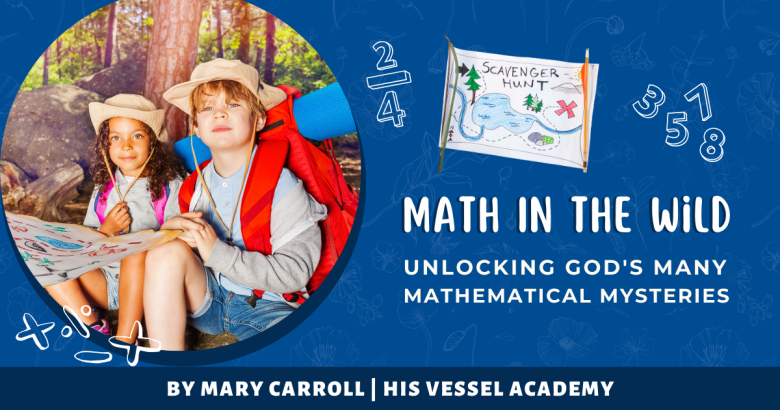By Mary Carroll of His Vessel Academy
Embark on an adventure where math meets the great outdoors. Beyond the confines of the classroom, mathematical wonders await, particularly within the realm of canal signs, shape scavenger hunts, spotting wildlife, and chalk number lines.
As we unravel the mysteries hidden within these adventures and more, we discover various opportunities for mathematical exploration.
From calculating park ages to deciphering canal dimensions, outdoor math offers a hands-on approach that enriches understanding and encourages a deeper connection with the world around us.
Join us as we dive into the captivating intersection of mathematics and nature, where every discovery becomes a testament to the beauty of God's creation.
Visiting Parks
For younger learners, a trip to the park becomes an engaging math lesson. As they read plaques detailing park histories and construction dates, prompt them to calculate the park's current age.
I love how this simple activity hones their arithmetic skills and fosters a connection between math and the natural world (their favorite parks). Encouraging them to explore different parks with varying plaques extends the learning experience, enriching their mathematical knowledge with each new park they visit.
Canal Plagues
Older students' adventure can deepen as they encounter canal plaques (signs). Take, for example, the Miami Canal plaque, which gives dimensions allowing them mathematical exploration.
Calculating the canal's volume becomes an intriguing challenge, with a width ranging from 26 to 40 feet and an average depth of 4.5 feet.
Moreover, the plaque unveils details about the locks, presenting dimensions ripe for mathematical challenges.
With 12 locks measuring 80 feet in length and 14 feet in width, calculating the lock's volume becomes as easy as multiplication.
Encourage Critical Thinking
If math is not easy for you and you need help creating a math problem from a plaque, challenge your children to do it instead. This way, they will also learn critical thinking. Once finished, they can see if you or one of their siblings can answer it.
Learn Engineering Concepts
Through these calculations, the allure of outdoor math extends beyond mere calculations. Your children will also gain insights into the engineering wonders that shape our landscapes.
By transforming plaque information into math problems, they cultivate a deeper understanding of mathematical concepts that will help their problem-solving abilities.
Another fun idea is transforming a hike into a scavenger hunt for shapes.
Scavenger Hunts
Begin by creating a scavenger hunt focusing on basic shapes: squares, rectangles, triangles, circles, and, for curious minds, parallel and perpendicular lines. For those exploring advanced shapes like trapezoids, parallelograms, or kites, extend the hunt to encompass these forms.
Embrace the spirit of curiosity; a simple walk can turn into a quest for parabolas, which are essentially arches—a fact that even non-mathematical parents can appreciate.
Scavenger Hunt Tips:
Here are some tips for parents needing help identifying these shapes: Parallel lines can be spotted among trees growing in the same direction.
There are parallel and perpendicular lines (and more) within the structure of a bridge. Parabolas reveal themselves in various forms, from a swing to gracefully curved branches.
Encourage children to explore, observe, and discover shapes in unexpected places. Whether it's a fallen twig resembling a triangle or a circular pond nestled amidst the trees, nature provides ample opportunities for mathematical exploration.
Nature Crafts
If scavenger hunts aren't your style, encourage children to craft shapes using twigs or rocks, reinforcing their understanding through hands-on engagement.
I noticed online resources offer a wide variety of math scavenger hunts to suit your different needs and your children's skill levels.
The Shapes Of Nature
As temperatures rise, seize the opportunity to explore a shape-seeking adventure with your children. The appeal of discovering shapes in nature fosters a love for learning that extends beyond the confines of the homeschool classroom.
Chalk Math Games
One of the greatest challenges for students is understanding negative numbers. To introduce or reinforce the concepts, create a number line outside using chalk on your sidewalk. You can create a number line using the numbers that are creating your biggest challenges.
Use positive numbers for your younger ages, giving them challenging numbers to add or subtract. Have them hop ten spaces, then hop back three spaces to tell you what 10 – 3 equals.
Add the negative integers to the number line for your older students and have them hop ten spaces and 13 spaces back to represent 10 – 13. This way, they can visualize the numbers and create concrete connections that are enjoyable outside in the fresh air.
To add to this challenge, use dice to determine the numbers or index cards with the numbers and operations to add variety to the game.
Hiking & Nature Walks
I always see animals, birds, or insects along our hikes. I encourage you to add a little science and math to your adventure. Have the students take pictures of the animal, bird, or insect, then use Google to determine their discovered species.
Encourage your children to document their wildlife encounters and newfound knowledge from each park visit. Have them write about the wildlife they observed and any fascinating information they learned that was unique to each new species and location.
Animal Unit-Studies
If you find your child interested in a particular animal, bird, or insect, begin to study it. Now, you have just created your first unit study. My youngest son took a particular interest in birds of all kinds.
We studied birds in our homeschool and collected feathers (before I knew about diseases). We created art projects and journals and learned about migration. Now, I have the privilege of helping my grandchildren learn about nature and all that God has created.
A fun math fact for rabbits:
If a rabbit has four litters in one year and the litter produces six young each time, how many rabbits will the female birth in one year?
Use this word problem to begin your math journey in nature. One of the animals we saw on our hike was the Eastern Cottontail Rabbit. Here is a great resource to discover more about this animal.
Conclusion
Utilize outdoor exploration to intertwine math and the wonders of nature. Challenge your children to see the beauty of mathematics woven into God's creation, from symmetry to lines, points, and planes.
So immerse yourself in the outdoors and embrace the opportunity to discover math in a whole new light.
Read More!
- Log in to post comments






